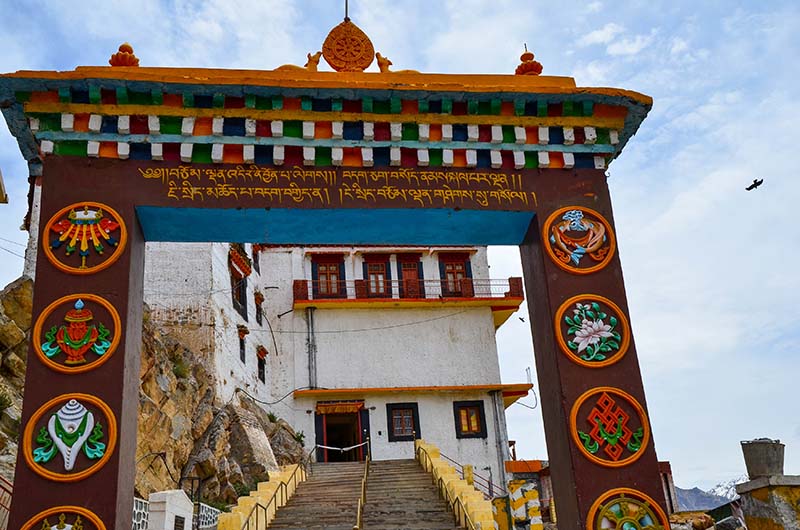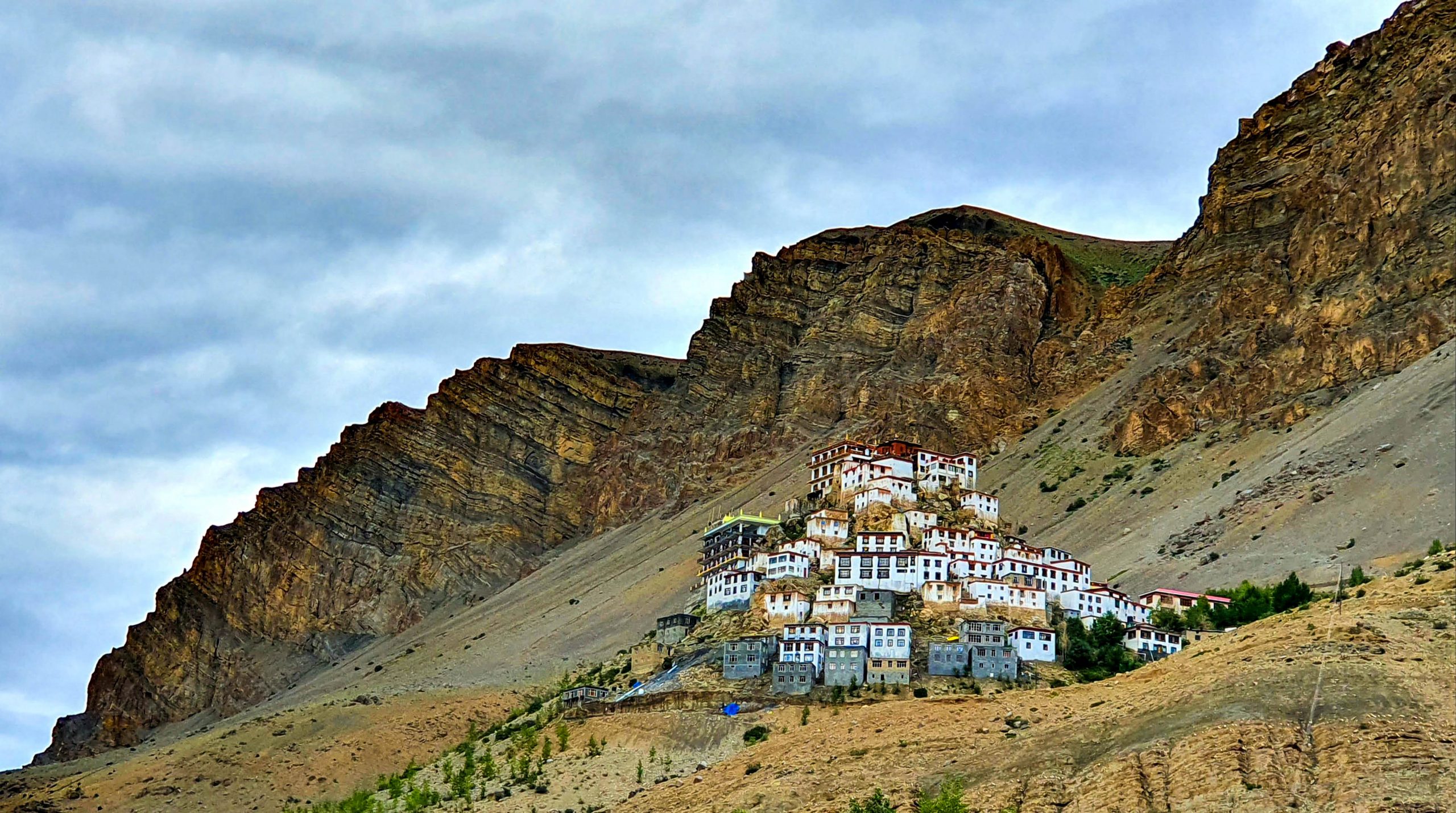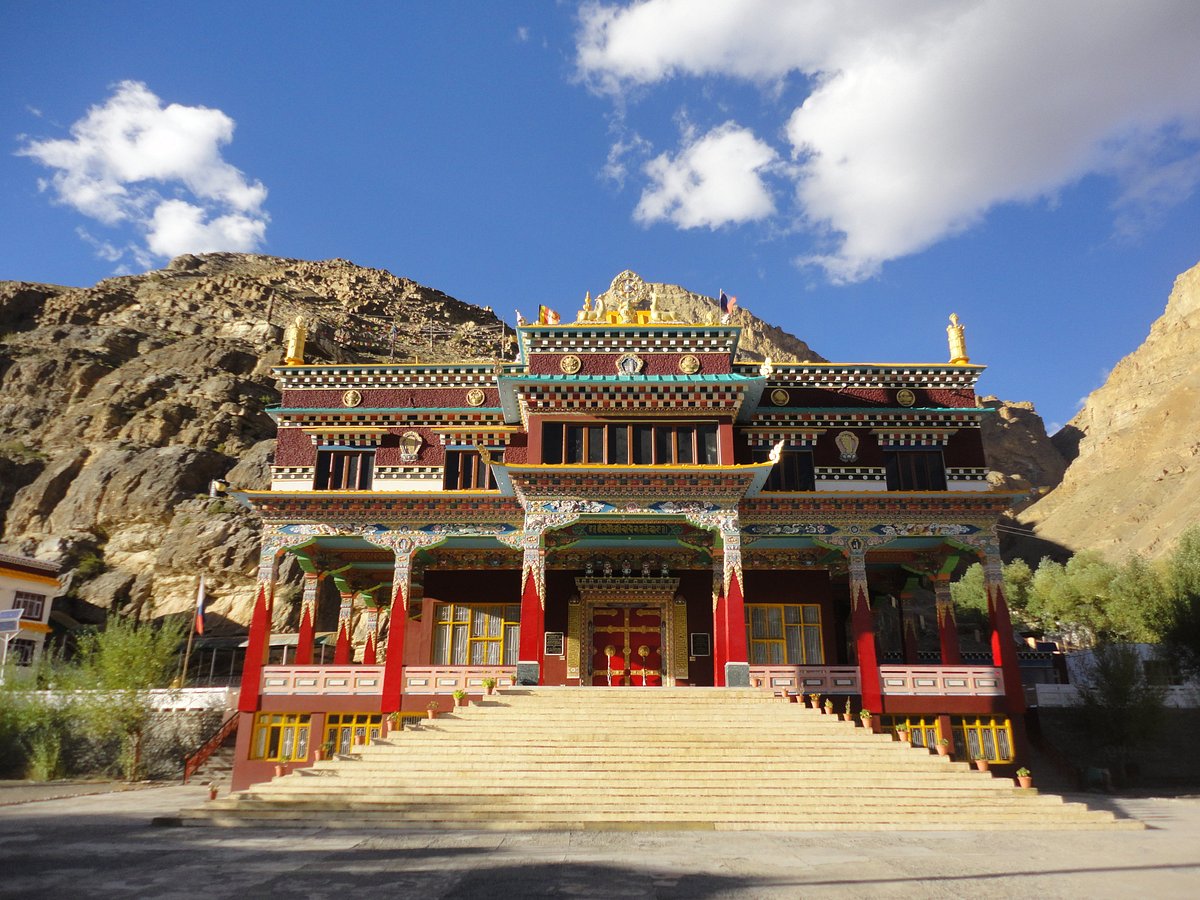Key Monastrey
Published on March 28, 2025
Perched precariously on a hilltop overlooking the Spiti Valley, Key Monastery (also spelled Kye Monastery ) stands as one of the most iconic and revered spiritual landmarks in the Himalayas. Located at an elevation of approximately 4,166 meters (13,668 feet), this ancient monastery is not just a religious site but also a symbol of resilience, art, and culture. Surrounded by barren mountains, deep valleys, and endless skies, Key Monastery offers a serene escape for travelers seeking spirituality, history, and breathtaking natural beauty.
The journey to Key Monastery is as awe-inspiring as the destination itself. Winding roads through rugged terrains and high-altitude passes like Kunzum La create a sense of anticipation and wonder. As you approach the monastery, its fortress-like architecture emerges against the stark landscape, exuding an aura of mystery and reverence. Known for its rich Buddhist heritage, stunning murals, and panoramic views, Key Monastery has remained a cornerstone of Tibetan Buddhism for centuries. Let’s delve deeper into what makes this sacred site such a remarkable destination and why it deserves a spot on every traveler’s bucket list.

The Allure of Key Monastery: A Spiritual and Architectural Marvel
Why Key Monastery Stands Out Among Himalayan Monasteries
When it comes to monastic grandeur, few places can rival the charm of Key Monastery . Situated in the heart of the Spiti Valley, this ancient Gompa serves as a hub of spirituality, learning, and art. Its unique location atop a hill offers breathtaking views of the surrounding mountains and valleys, making it a perfect blend of nature and divinity.
One of the standout features of Key Monastery is its architectural brilliance. The monastery’s fortress-like design not only reflects its historical importance but also symbolizes resilience against invasions and harsh weather conditions. Built in the 11th century, Key Monastery has withstood the test of time, surviving attacks, earthquakes, and natural calamities while preserving its sacred essence.
A Journey Through Time: The History of Key Monastery
Key Monastery is believed to have been founded by Dromtön, a disciple of the renowned Buddhist philosopher Atisha, in the 11th century. Over the centuries, it has served as a center for Buddhist teachings, housing thousands of monks and scholars. The monastery has witnessed numerous invasions, including those by Mongols and Dogra forces, which left their mark on its structure and history.
Despite these challenges, Key Monastery has continued to thrive as a beacon of Tibetan Buddhism. Today, it houses ancient murals, thangkas (Buddhist paintings), and statues of deities, offering a glimpse into the rich cultural heritage of the region. For many travelers, visiting Key Monastery becomes a transformative experience, leaving them with a deeper understanding of life and spirituality.

Iconic Features of Key Monastery: Must-See Highlights
Architectural Splendor: A Fortress of Faith
Key Monastery’s architecture is a testament to the ingenuity and craftsmanship of its builders. The monastery’s multi-story structure resembles a fortress, with narrow staircases, dimly lit corridors, and prayer halls adorned with intricate carvings and murals. The walls are painted with vibrant frescoes depicting scenes from Buddhist mythology, while the ceilings are decorated with colorful mandalas.
The monastery’s design is not just aesthetically pleasing but also functional. Its elevated position and thick walls provide insulation against the harsh winters of the Spiti Valley, while its labyrinthine layout creates a sense of mystery and exploration. Every corner of Key Monastery tells a story—of faith, perseverance, and artistic excellence.
Sacred Relics and Artifacts: Treasures of Tibetan Buddhism
Inside Key Monastery, visitors will find a treasure trove of sacred relics and artifacts that reflect the monastery’s rich history. The prayer halls house ancient statues of Buddha and other deities, each intricately carved and beautifully adorned. Thangkas, or Buddhist paintings, line the walls, depicting various aspects of Buddhist philosophy and cosmology.
One of the highlights of the monastery is its library, which contains rare manuscripts and texts written in Tibetan script. These documents serve as invaluable resources for scholars and monks studying Buddhist teachings. Visitors are often struck by the reverence with which these relics are preserved, a testament to the monastery’s enduring legacy.

Panoramic Views: A Feast for the Eyes
One of the most unforgettable aspects of Key Monastery is its location. Perched atop a hill, the monastery offers panoramic views of the Spiti Valley, with snow-capped peaks, barren mountains, and winding rivers stretching as far as the eye can see. The view is especially breathtaking during sunrise and sunset, when the golden light bathes the landscape in a warm glow.
Visitors can spend hours simply gazing at the horizon, feeling a profound connection to nature and the universe. Photographers will find endless opportunities to capture the beauty of the surroundings, from the rugged terrain to the fluttering prayer flags that adorn the monastery.
Experiencing Key Monastery: Rituals, Festivals, and Daily Life
Monastic Life: A Day in the Life of the Monks
Key Monastery is home to a small community of monks who dedicate their lives to the study and practice of Tibetan Buddhism. Their daily routine includes meditation, prayer sessions, and rituals that have been passed down through generations. Visitors are welcome to observe these practices, gaining insight into the spiritual discipline and devotion that define monastic life.
During prayer sessions, the air is filled with the sound of chanting, drums, and cymbals, creating an atmosphere of tranquility and reverence. Monks often invite visitors to participate in these rituals, offering blessings and guidance. For many travelers, these interactions become some of the most meaningful moments of their visit.
![]()
Festivals: Celebrating Spirituality and Culture
Life at Key Monastery revolves around festivals that celebrate nature, agriculture, and spirituality. One of the most significant events is Losar , the Tibetan New Year, which marks the beginning of the agricultural cycle. During this time, the entire monastery comes alive with music, dance, and elaborate rituals. Locals dress in colorful traditional attire, and special prayers are held to invoke blessings for prosperity.
Another notable festival is Chakhar , a masked dance festival where monks perform traditional dances wearing elaborate costumes and masks. These performances are not just entertainment but also a form of spiritual expression, symbolizing the triumph of good over evil. Participating in these celebrations allows travelers to immerse themselves in the rich tapestry of Spitian culture, forging connections that transcend language barriers.
Adventure Beyond Key Monastery: Exploring the Surrounding Area
Trekking Trails: Discovering Hidden Gems
For adventure enthusiasts, the area around Key Monastery offers several trekking trails that lead to some of the most breathtaking landscapes in the Spiti Valley. One popular route is the Key to Kibber Trek , which takes you through barren deserts, glacial streams, and picturesque villages. Along the way, you’ll encounter diverse flora and fauna, including rare species like the Himalayan marmot and snow leopard.
Reaching Kibber, one of the highest motorable villages in the world, is a rewarding experience. The village offers stunning views of the surrounding peaks and valleys, making it an ideal destination for photography and stargazing. Spending a night here, under a blanket of stars, is an unforgettable experience that leaves you feeling connected to the universe.

Stargazing: A Celestial Spectacle
The high altitude and minimal light pollution around Key Monastery make it one of the best places in the world for stargazing. On a clear night, the sky transforms into a canvas of twinkling stars, constellations, and even the Milky Way. For astronomy enthusiasts, this is a once-in-a-lifetime experience. Even casual observers will find themselves awestruck by the sheer vastness of the universe above.
The absence of artificial lights amplifies the brilliance of the night sky. Constellations like Orion, Cassiopeia, and the Big Dipper shine brightly, while shooting stars streak across the heavens. For those who bring telescopes or binoculars, the view is even more mesmerizing. You can spot planets like Jupiter and Saturn, their rings and moons visible as tiny specks of light.
Spending a night under the stars near Key Monastery is a humbling experience. It reminds us of our place in the cosmos and fills us with a sense of wonder. Whether you’re lying on the ground, wrapped in a blanket, or sitting by a campfire, the night sky in this region is something you’ll never forget.
Practical Tips for Visiting Key Monastery
When to Visit: Timing Is Everything
The best time to visit Key Monastery is during the summer months of May to September , when the weather is pleasant, and all roads are accessible. Autumn (October) offers stunning fall colors, while winter (November to April) transforms the region into a snowy wonderland—but be prepared for extreme cold and limited accessibility.
During the summer, temperatures range from 10°C to 20°C (50°F to 68°F) during the day, dropping significantly at night. Winters are harsh, with temperatures plummeting to -20°C (-4°F) or lower. If you plan to visit during the winter, ensure you’re well-prepared with warm clothing, sturdy boots, and emergency supplies.

Getting There: The Journey Is Part of the Adventure
Reaching Key Monastery requires careful planning. The nearest major town is Kaza , about 12 kilometers away. From there, you can hire a taxi or take a shared jeep to the monastery via a scenic yet rugged road. The drive offers stunning views of the Spiti Valley, with barren mountains, glacial rivers, and traditional villages along the way.
If you’re traveling from Delhi or Manali, plan for a multi-day journey. The route involves crossing Rohtang Pass and Kunzum Pass, both of which are closed during the winter months due to heavy snowfall. Hiring a private vehicle ensures greater flexibility and comfort, especially if you’re traveling with family or friends.
Where to Stay: Embrace Local Hospitality
Accommodation options near Key Monastery are limited but authentic. Homestays run by local families offer a chance to experience traditional Spitian life firsthand. You’ll sleep in cozy mud-brick houses, enjoy homemade meals, and share stories with your hosts around a warm fire.
Homestays typically include basic amenities like bedding, hot water, and meals. Don’t expect luxury—this is a rustic experience designed to immerse you in the local way of life. Meals are hearty and delicious, featuring traditional dishes like thukpa (noodle soup), momos (steamed dumplings), and siddu (steamed bread stuffed with walnuts or poppy seeds).
For those who prefer camping, several operators organize tented stays near the monastery. Imagine falling asleep to the sound of silence and waking up to the sight of snow-capped peaks—it doesn’t get better than this!

Why Key Monastery Should Be on Your Travel List
Key Monastery is more than just a religious site—it’s a living testament to the resilience, art, and spirituality of the Spiti Valley. From its architectural brilliance and sacred relics to its panoramic views and cultural richness, every aspect of the monastery leaves a lasting impression. Whether you’re a spiritual seeker, a history enthusiast, or someone simply looking to connect with nature, Key Monastery has something for everyone.
The monastery’s isolation has preserved its pristine environment and traditional way of life. Visitors are often struck by the simplicity and warmth of the locals, who live in harmony with the harsh yet beautiful surroundings. Every interaction, every meal, and every step you take near Key Monastery leaves a lasting impression.
So pack your bags, lace up your boots, and embark on a journey to this hidden gem in the Himalayas. Share your stories and inspire others to explore the magic of Key Monastery!
Frequenlty Asked Questions
Where is Key Monastery located and why is it significant?
Key Monastery is a 1,000-year-old Tibetan Buddhist monastery in Spiti Valley, Himachal Pradesh, perched at 4,166 meters (13,668 ft). It's the largest and most important monastery in Spiti Valley, known for its ancient murals, scriptures, and stunning architecture.
What is the best time to visit Key Monastery?
The ideal months are May to October when the roads are open and temperatures are pleasant (5°C to 15°C). November to April brings heavy snowfall, making access difficult.
Do I need a permit to visit Key Monastery?
Indian citizens do not need a permit, but foreign nationals require a Protected Area Permit (PAP) for Spiti Valley, available in Shimla or Reckong Peo.
How do I reach Key Monastery from Kaza?
Key Monastery is just 12 km from Kaza (30-40 minute drive). Taxis and shared jeeps are easily available. The route offers breathtaking views of the Spiti River valley.
What are the must-see highlights of Key Monastery?
-
Ancient Thangka paintings and murals
-
Sacred Buddhist scriptures over 500 years old
-
Stunning panoramic views of Spiti Valley
-
Meditation caves used by monks for centuries
Is there mobile network or internet at Key Monastery?
BSNL works intermittently, while other networks have no coverage. There is no internet access, making it perfect for a peaceful retreat.
Are there accommodation options near Key Monastery?
Basic guesthouses and homestays (₹800-1,500/night) are available nearby. Most visitors stay in Kaza and visit the monastery as a day trip.
Can I visit Key Monastery in winter?
Yes, but only via the Shimla-Kaza route (Manali route is closed). December to February sees extreme cold (-15°C to -25°C), and the monastery may have limited access.
Is photography allowed inside Key Monastery?
Photography is allowed in the outer areas, but restricted in prayer halls and certain sacred sections. Always ask for permission before clicking pictures of monks or rituals.
What should I wear when visiting Key Monastery?
-
Modest clothing (cover shoulders and knees)
-
Comfortable shoes (monastery has steep stairs)
-
Warm layers (even summers are chilly at this altitude)
